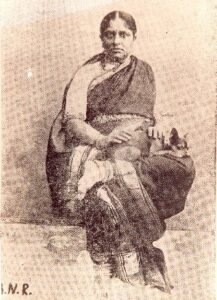Read in : தமிழ்
English man Charles Philip Brown, who created the Telugu – English dictionary, found a bunch of palm scripts at Oriental Manuscript Library in 1855. The manuscript was of 584 poems written by Devadasi Muddupalani. Brown managed to get these Telugu poems on print with the help of his colleague Baidipatti Venkata Narasu. The book Radhika Santvanam, with the author’s biography, was first published by Brown in 1877.
Englishman Charles Philip Brown, who created the Telugu – English dictionary, found a bunch of palm scripts at Oriental Manuscript Library in 1855. The manuscript contained 584 poems written by Devadasi Muddupalani who lived in the 18th century

Bangalore Nagarathnamma
The book went on reprint again in 1907 after removing some overtly romantic poems. The book landed in the hands of Bangalore Nagarathnamma (1878 – 1952). Nagarathnamma, who also hailed from the Devadasi clan, was wonderstruck by Muddupalani’s book. Nagarathnamma was a reputed personality and had built a memorial hall for Thiagarajar at Thiruvaiyaru. She found that the book was incomplete and did not have any author description. Nagarathnamma started working on the reprint.
Who was Muddupalani and what is so controversial about her book Radhika Santvanam? Muddupalani or Muthupazhani (1739 – 1790) was a courtesan of King Pratab Singh, the Maratha King who ruled Tanjore. She was the granddaughter of acclaimed singer and devadasi Tanjanayaki. Muddupalani was well-versed in Tamil, Telugu and Sanskrit. Muddupalani reprised Aandal’s Thirupavai in seven-lined songs Saptapadalu. Her effort was lauded by the king.
Muddupalani wrote Radhika Santvanam during that period. The four-chapter book with 584 poems is also called Ila Deviyamu. The poetic genre is an erotic narrative dealing with the relationship of Lord Krishna with his friend Radha and his new wife Ila. The book talks about how a jealous Radha was placated.
After the book landed in the hands of Nagarathnamma, she started taking efforts to reprint the book with all the poems and an author bio. When she published the book in 1910, Nagarathnamma challenged the critics in the foreword she wrote. The book was published by a leading Telugu publisher in Chennai, Vavilla Ramaswami Sastrulu.
Another year passed without any incidents but Telugu magazine Sasilekha published an article criticizing the book, stating it was obscene. Author Veeresalingam and his supporters launched a campaign against the book. Yielding to pressure, the British government banned the book in 1911.
Telugu magazine Sasilekha published an article criticizing the book stating it had obscene content. Author Veeresalingam and his supporters campaigned against the book Radhika Santvanam. Yielding to pressure, the British government banned the book in 1911. The books on print were destroyed though previous editions survived the onslaught
The book, The Devadasi and the Saint, authored by Venkatakrishnan Sriram narrates all the controversies surrounding Radhika Santvanam. Sandhya Mulchandani translated the book from Telugu to English. Penguin published the English translation in 2011. Assistant Professor at Delhi University, Umadevi translated the book in Tamil. In her foreword, she compared Muddupalani with women poets of the Sangam era who did not shy away from writing romantic poems.
Read in : தமிழ்











